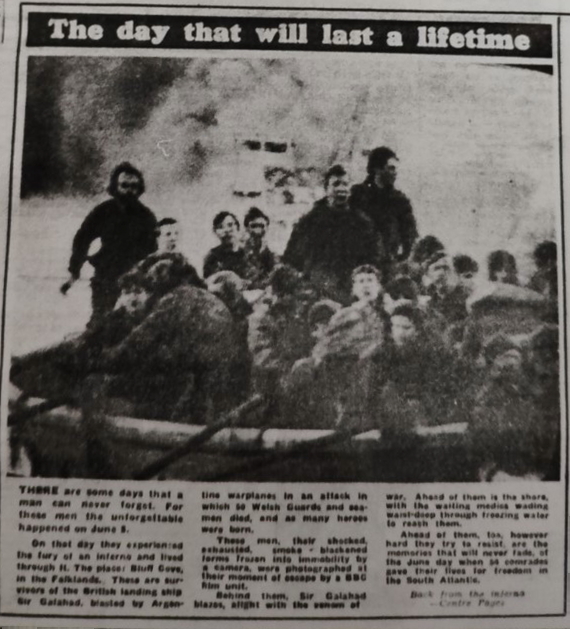Below is the account of Weaverham resident and Falklands veteran Tom Navin who served in 1982 as a combat medic as part of The Red and Green Life Machine.

‘I passed out from basic training in March 1982 aged 18 qualifying as a Combat Medic and posted to 16 Fd Ambulance in Aldershot whose medics were attached to every regiment in theatre plus a field surgical team.
A spearhead unit was a hive of activity when we arrived, with equipment and stores being moved around, there was talk of war in Scotland! (At this point it was a rumour and no-one knew where the Falkland Islands were.)
Weeks later I was flying on a VC10 to Ascension Island where I boarded a helicopter then was winched onto the QE2.
Our journey continued, the engines in full throttle cutting their way effortlessly through the waves towards the South Atlantic.
Our training regime consisted of mandatory physical exercise, live firing out to sea, studying maps and topography, fieldcraft and undertaking training on advanced trauma and life support, gunshot wounds, blast and thermal injuries.
In the weeks to come we would be getting plenty of opportunities to put these skills into practice.
We transferred from the QE2 to the SS Norland at South Georgia for the final leg of the journey before transferring to San Carlos by LCU.
We spent a while living in trenches in San Carlos stagging on and I witnessed ships and planes being blown up in ‘Bomb Alley’
Word came through that the Welsh Guards were travelling by RFA Sir Galahad, and our company had hitched a lift.
After an overnight stay we were all ready to get our feet back on Falkland’s soil, Galahad was a troop ship, similar to a ferry, it lacked the defences of a warship, only carrying machine guns.
Whilst awaiting further instructions I returned to my bunk for a final check of my kit.
The ship’s hold/tank deck containing ammunition and the mortar platoon of the Welsh Guards was hit by two 1000lb bombs dropped by Argentinian Skyhawks.
The lights were down; we were plunged into complete darkness.
I left my bunk and headed into the corridor to be faced by a huge uncontrollable ball of fire, as black as ink with fireworks flashing in the centre, smoke and flames blew out; the smell of cordite hit my nostrils, explosions and rounds whizzing, zinging and cracking randomly out of the flames.
Eventually I followed some lads who were on fire, and we navigated through rubble and across a void where the stairs used to be (the ship had also been hit the day before and you could see right through the hole down towards to sea) heading towards the pin of light from above that shone through the rubble illuminating the deck.
It was carnage on deck, but my training kicked in as I joined the other medics to treat and evacuate the casualties onto choppers.
I recall turning around when the helicopters stopped coming (they ran out of fuel), and we were the last on the ship with Chinese Crew casualties with severe burns. We shepherded them down the emergency ladders into a small rubber life raft. We found a medical kit in the life raft and started treated their burns.

Our dingy was being sucked towards the ship, thick black smoke and rounds engulfing us. We frantically used the lid and the first aid box as paddles to try to paddle away from the bullets and smoke but kept getting sucked back in.
We felt a draught and heard the sounds of a helicopter that pushed us away with the down draught from its blades from the smoke and explosions.
After spending the night in the sheep sheds at Fitzroy I was transferred to work at The Red and Green Life Machine, a field surgical team that was an abandoned slaughterhouse at Ajax Bay under the command of Rick Jolley and part of the Royal Marine Commandos.
My days and nights were spent treating the injuries of British and Argentine casualties that came in thick and fast.
We also had to look after the 100’s of prisoners who were housed at the back of the building where there were two unexploded 1000lb bombs that had landed.
The day after the war ended, I was flown into Port Stanley. I couldn’t believe how many Argentine soldiers there were compared to our troops. Their officers were still carrying weapons. We were told it was to keep their troops in line, but we know it was probably to stop them getting attacked by their own men as the Officers had not treated their soldiers well.
A unit is like a family, and we lost three of our family members on the Sir Galahad
Major Roger Nutbeem RAMC (1942-1982)
Lance Corporal Ian Farrell (‘Scouse’) RAMC (1960 – 1982)
Private Kenny Preston RAMC (1961-1982)
I returned to the Falklands on the 30th anniversary with my wife.
It was important to return.
I’d treated casualties from every battle, and I wanted to see the battlefields and pay my respects to the lads that didn’t come back. We returned to what was left of the Red and Green Life Machine and to Fitzroy. It was a pilgrimage.
I dedicate this article to all those who lost their lives both British, Argentine KIA and the three Falkland Islanders and to those who suffer the physical and mental scars of war.’

